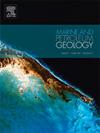Simulation of early karstification by synergistic mixing corrosion and retrograde solubility in carbonate reservoirs
IF 3.7
2区 地球科学
Q1 GEOSCIENCES, MULTIDISCIPLINARY
引用次数: 0
Abstract
The mixing of groundwater with varying carbon dioxide content and temperature plays a crucial role in karst evolution in carbonate reservoirs, driving both mixing corrosion and retrograde solubility. Research on karst evolution has primarily focused on independent mixing corrosion (MC), while the synergistic effect of mixing corrosion and retrograde solubility (MR) has received limited attention. This study employs a previously developed hydro-thermal-chemical coupled model to analyze the early karstification of a limestone basin system recharged by meteoric and cross-formational waters, varying in , Ca2+ concentrations, and temperatures. The model incorporates structural heterogeneity and inflow aggressiveness to simulate two scenarios: MC and MR, for comparison. The results show that MC is more likely to occur in shallow aquifers, promoting preferential pathways along the water table. In contrast, MR not only accelerates dissolution at the water table but also increases flow fluxes and the extent of karstification at greater depths. As the decreasing aggressiveness of meteoric water weakens the nonlinear kinetics of dissolution, the duration of early karstification by MC is significantly longer than that of MR. In the shorter karst evolution process driven by MR, increased flow fluxes and conduit diameters at greater depths facilitate the development of longer vertical permeable tunnels along the faults, while hindering conduits enlargement at the water table. These findings reveal distinct modes of karstification for MC and MR, highlighting the significant role of heat and chemistry heterogeneity in karst evolution. This study provides deeper insights into carbonate reservoirs and offers practical implications for improving the efficiency of hydrothermal resource exploitation and geological CO2 storage.
碳酸盐岩储集层溶蚀与逆行溶解度协同混合作用的早期岩溶模拟
不同二氧化碳含量和温度的地下水混合在碳酸盐岩储层岩溶演化中起着至关重要的作用,同时驱动混合腐蚀和逆行溶解度。对岩溶演化的研究主要集中在独立混合腐蚀(MC)上,混合腐蚀与逆行溶解度(MR)的协同效应研究较少。本研究采用先前开发的水-热-化学耦合模型来分析由大气和跨地层水补给的石灰岩盆地系统的早期岩溶作用,这些水在P(CO2)、Ca2+浓度和温度上都有变化。该模型结合了结构异质性和流入侵略性来模拟两种情景:MC和MR,以进行比较。结果表明,MC更可能发生在浅层含水层,沿地下水位形成优先通道。相反,MR不仅加速了地下水位的溶解,而且增加了更深层的流量和岩溶程度。由于大气水侵蚀性的减弱削弱了溶蚀的非线性动力学,MC早期岩溶作用的持续时间明显长于MR。MR驱动的较短岩溶演化过程中,较大深度的流量和管道直径的增加有利于沿断层发育较长的垂直透水隧道,同时阻碍了地下水位处管道的扩大。这些发现揭示了MC和MR岩溶作用的不同模式,突出了热化学非均质性在岩溶演化中的重要作用。该研究为进一步认识碳酸盐岩储层提供了理论依据,对提高热液资源开发效率和地质CO2封存具有现实意义。
本文章由计算机程序翻译,如有差异,请以英文原文为准。
求助全文
约1分钟内获得全文
求助全文
来源期刊

Marine and Petroleum Geology
地学-地球科学综合
CiteScore
8.80
自引率
14.30%
发文量
475
审稿时长
63 days
期刊介绍:
Marine and Petroleum Geology is the pre-eminent international forum for the exchange of multidisciplinary concepts, interpretations and techniques for all concerned with marine and petroleum geology in industry, government and academia. Rapid bimonthly publication allows early communications of papers or short communications to the geoscience community.
Marine and Petroleum Geology is essential reading for geologists, geophysicists and explorationists in industry, government and academia working in the following areas: marine geology; basin analysis and evaluation; organic geochemistry; reserve/resource estimation; seismic stratigraphy; thermal models of basic evolution; sedimentary geology; continental margins; geophysical interpretation; structural geology/tectonics; formation evaluation techniques; well logging.
 求助内容:
求助内容: 应助结果提醒方式:
应助结果提醒方式:


